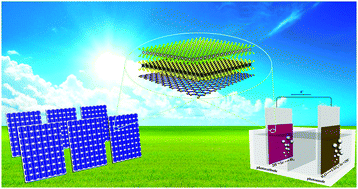当前位置:
X-MOL 学术
›
Chem. Soc. Rev.
›
论文详情
Our official English website, www.x-mol.net, welcomes your
feedback! (Note: you will need to create a separate account there.)
Engineering graphene and TMDs based van der Waals heterostructures for photovoltaic and photoelectrochemical solar energy conversion†
Chemical Society Reviews ( IF 40.4 ) Pub Date : 2018-05-08 00:00:00 , DOI: 10.1039/c8cs00067k Changli Li 1, 2, 3, 4, 5 , Qi Cao 6, 7, 8, 9 , Faze Wang 5, 10, 11, 12 , Yequan Xiao 5, 10, 11, 12 , Yanbo Li 5, 10, 11, 12 , Jean-Jacques Delaunay 6, 7, 8, 9 , Hongwei Zhu 1, 2, 3, 4, 5
Chemical Society Reviews ( IF 40.4 ) Pub Date : 2018-05-08 00:00:00 , DOI: 10.1039/c8cs00067k Changli Li 1, 2, 3, 4, 5 , Qi Cao 6, 7, 8, 9 , Faze Wang 5, 10, 11, 12 , Yequan Xiao 5, 10, 11, 12 , Yanbo Li 5, 10, 11, 12 , Jean-Jacques Delaunay 6, 7, 8, 9 , Hongwei Zhu 1, 2, 3, 4, 5
Affiliation

|
Graphene and two-dimensional (2D) transition metal dichalcogenides (TMDs) have attracted significant interest due to their unique properties that cannot be obtained in their bulk counterparts. These atomically thin 2D materials have demonstrated strong light–matter interactions, tunable optical bandgap structures and unique structural and electrical properties, rendering possible the high conversion efficiency of solar energy with a minimal amount of active absorber material. The isolated 2D monolayer can be stacked into arbitrary van der Waals (vdWs) heterostructures without the need to consider lattice matching. Several combinations of 2D/3D and 2D/2D materials have been assembled to create vdWs heterojunctions for photovoltaic (PV) and photoelectrochemical (PEC) energy conversion. However, the complex, less-constrained, and more environmentally vulnerable interface in a vdWs heterojunction is different from that of a conventional, epitaxially grown heterojunction, engendering new challenges for surface and interface engineering. In this review, the physics of band alignment, the chemistry of surface modification and the behavior of photoexcited charge transfer at the interface during PV and PEC processes will be discussed. We will present a survey of the recent progress and challenges of 2D/3D and 2D/2D vdWs heterojunctions, with emphasis on their applicability to PV and PEC devices. Finally, we will discuss emerging issues yet to be explored for 2D materials to achieve high solar energy conversion efficiency and possible strategies to improve their performance.
中文翻译:

基于石墨烯和TMD的工程范德华异质结构用于光伏和光电化学太阳能转换†
石墨烯和二维(2D)过渡金属二硫化二氢(TMDs)由于其独特的性能而无法引起大量关注,因此引起了人们的极大兴趣。这些原子薄的2D材料已显示出强大的光-物质相互作用,可调节的光学带隙结构以及独特的结构和电特性,从而可以在使用最少量的活性吸收剂材料的情况下实现太阳能的高转换效率。隔离的2D单层可以堆叠为任意的范德华(vdWs)异质结构,而无需考虑晶格匹配。已组装2D / 3D和2D / 2D材料的几种组合,以创建用于光伏(PV)和光电化学(PEC)能量转换的vdWs异质结。但是,复杂,约束较少,vdWs异质结中对环境更不利的界面不同于传统的外延生长的异质结,这给表面和界面工程带来了新的挑战。在这篇综述中,将讨论带对准的物理原理,表面改性的化学性质以及在PV和PEC过程中界面处的光激发电荷转移行为。我们将介绍2D / 3D和2D / 2D vdW异质结的最新进展和挑战,重点是它们在PV和PEC器件中的适用性。最后,我们将讨论2D材料要实现高太阳能转换效率尚待探索的新兴问题,以及改善其性能的可能策略。外延生长的异质结,为表面和界面工程带来了新的挑战。在这篇综述中,将讨论带对准的物理原理,表面改性的化学性质以及在PV和PEC过程中界面处的光激发电荷转移行为。我们将介绍2D / 3D和2D / 2D vdW异质结的最新进展和挑战,重点是它们在PV和PEC器件中的适用性。最后,我们将讨论2D材料要实现高太阳能转换效率尚待探索的新兴问题,以及改善其性能的可能策略。外延生长的异质结,为表面和界面工程带来了新的挑战。在这篇综述中,将讨论带对准的物理原理,表面改性的化学性质以及在PV和PEC过程中界面处的光激发电荷转移行为。我们将介绍2D / 3D和2D / 2D vdW异质结的最新进展和挑战,重点是它们在PV和PEC器件中的适用性。最后,我们将讨论2D材料要实现高太阳能转换效率尚待探索的新兴问题,以及改善其性能的可能策略。在PV和PEC过程中,将讨论表面改性的化学性质以及界面处的光激发电荷转移行为。我们将介绍2D / 3D和2D / 2D vdW异质结的最新进展和挑战,重点是它们在PV和PEC器件中的适用性。最后,我们将讨论2D材料要实现高太阳能转换效率尚待探索的新兴问题,以及改善其性能的可能策略。在PV和PEC过程中,将讨论表面改性的化学性质以及界面处的光激发电荷转移行为。我们将介绍2D / 3D和2D / 2D vdW异质结的最新进展和挑战,重点是它们在PV和PEC器件中的适用性。最后,我们将讨论2D材料要实现高太阳能转换效率尚待探索的新兴问题,以及改善其性能的可能策略。
更新日期:2018-05-08
中文翻译:

基于石墨烯和TMD的工程范德华异质结构用于光伏和光电化学太阳能转换†
石墨烯和二维(2D)过渡金属二硫化二氢(TMDs)由于其独特的性能而无法引起大量关注,因此引起了人们的极大兴趣。这些原子薄的2D材料已显示出强大的光-物质相互作用,可调节的光学带隙结构以及独特的结构和电特性,从而可以在使用最少量的活性吸收剂材料的情况下实现太阳能的高转换效率。隔离的2D单层可以堆叠为任意的范德华(vdWs)异质结构,而无需考虑晶格匹配。已组装2D / 3D和2D / 2D材料的几种组合,以创建用于光伏(PV)和光电化学(PEC)能量转换的vdWs异质结。但是,复杂,约束较少,vdWs异质结中对环境更不利的界面不同于传统的外延生长的异质结,这给表面和界面工程带来了新的挑战。在这篇综述中,将讨论带对准的物理原理,表面改性的化学性质以及在PV和PEC过程中界面处的光激发电荷转移行为。我们将介绍2D / 3D和2D / 2D vdW异质结的最新进展和挑战,重点是它们在PV和PEC器件中的适用性。最后,我们将讨论2D材料要实现高太阳能转换效率尚待探索的新兴问题,以及改善其性能的可能策略。外延生长的异质结,为表面和界面工程带来了新的挑战。在这篇综述中,将讨论带对准的物理原理,表面改性的化学性质以及在PV和PEC过程中界面处的光激发电荷转移行为。我们将介绍2D / 3D和2D / 2D vdW异质结的最新进展和挑战,重点是它们在PV和PEC器件中的适用性。最后,我们将讨论2D材料要实现高太阳能转换效率尚待探索的新兴问题,以及改善其性能的可能策略。外延生长的异质结,为表面和界面工程带来了新的挑战。在这篇综述中,将讨论带对准的物理原理,表面改性的化学性质以及在PV和PEC过程中界面处的光激发电荷转移行为。我们将介绍2D / 3D和2D / 2D vdW异质结的最新进展和挑战,重点是它们在PV和PEC器件中的适用性。最后,我们将讨论2D材料要实现高太阳能转换效率尚待探索的新兴问题,以及改善其性能的可能策略。在PV和PEC过程中,将讨论表面改性的化学性质以及界面处的光激发电荷转移行为。我们将介绍2D / 3D和2D / 2D vdW异质结的最新进展和挑战,重点是它们在PV和PEC器件中的适用性。最后,我们将讨论2D材料要实现高太阳能转换效率尚待探索的新兴问题,以及改善其性能的可能策略。在PV和PEC过程中,将讨论表面改性的化学性质以及界面处的光激发电荷转移行为。我们将介绍2D / 3D和2D / 2D vdW异质结的最新进展和挑战,重点是它们在PV和PEC器件中的适用性。最后,我们将讨论2D材料要实现高太阳能转换效率尚待探索的新兴问题,以及改善其性能的可能策略。











































 京公网安备 11010802027423号
京公网安备 11010802027423号